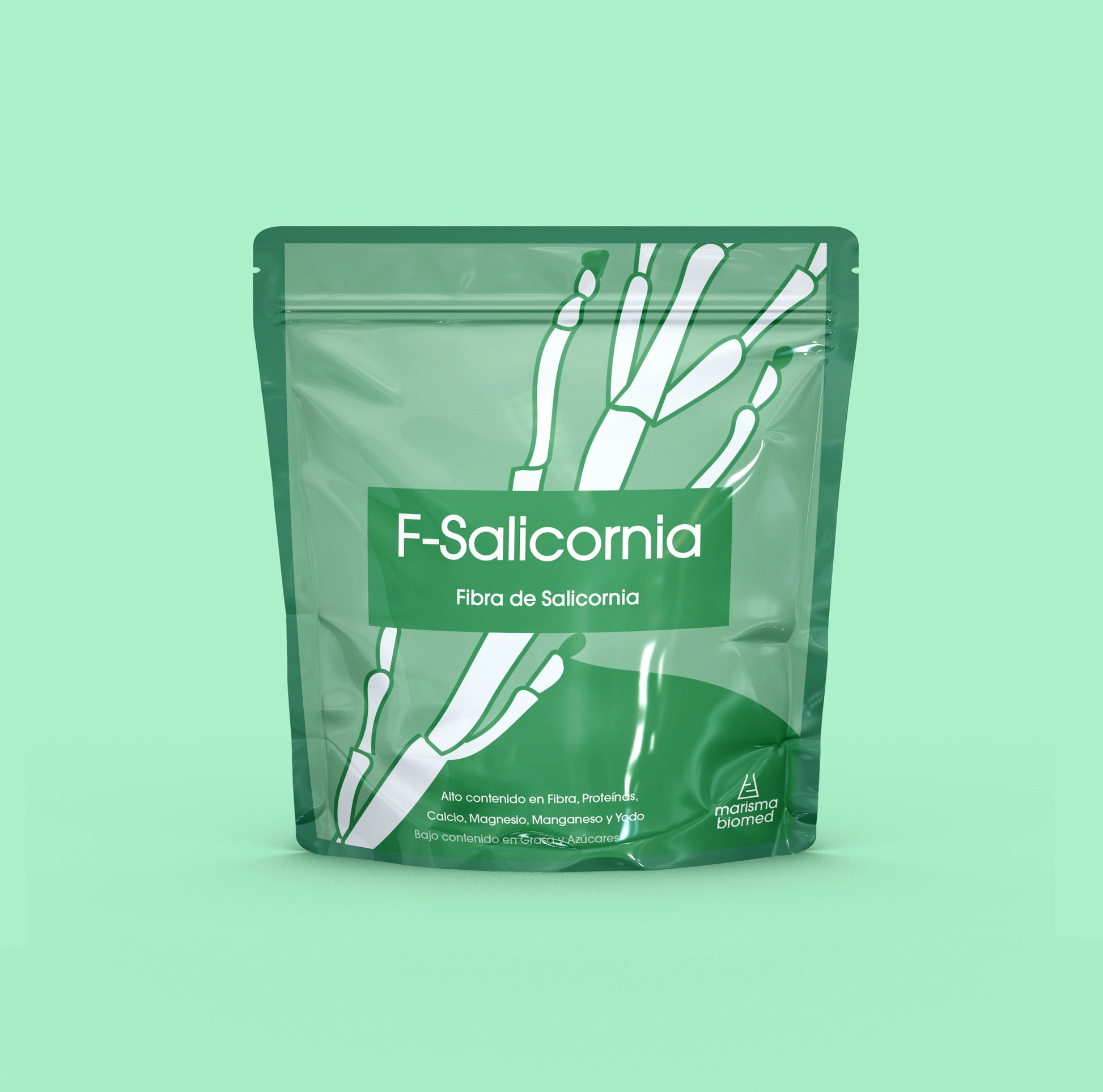Marisma Biomed
F-Salicornia
F-Salicornia
Couldn't load pickup availability
Food supplement rich in soluble vegetable fibre from European Salicornia. Fibre is an indispensable component of healthy nutrition.
Although fibre cannot be digested and absorbed by the body, it is of great health value and is essential for maintaining a healthy intestinal transit.
While it is preferable to increase your fibre intake through a diet rich in fruit and vegetables, in cases where it is not possible to change your diet, you can opt for supplements such as F-Salicornia.
Composition
Composition
European Salicornia fibre ground to a fine soluble green powder.
F-salicornia has 10 times more fibre than required by EFSA for ‘High fibre content’ labelling.
A food can only claim to be high in fibre if the product contains at least 6g of fibre per 100g, with F-Salicornia having more than 60g per 100g of product.
Benefits
Benefits
- Sensation of satiety.
- Improves intestinal transit.
- Decreases the rate of glucose absorption.
- Develops intestinal flora and increases the excretion of fat, cholesterol, bile salts and protein.
- Protective effect on cardiovascular disease.
- Lower risk of first stroke [Threapleton DE, et al. Stroke].
- Magnesium helps to reduce tiredness and fatigue.
If you want to have good gastrointestinal health, you cannot forget to include soluble and insoluble fibre in your diet on a daily basis [Escudero Álvarez E, et al. Nutr Hosp].
Recommendations for use
Recommendations for use
In Europe the average fibre intake is 17-23g.
The recommendation is to consume at least 25g of fibre per day, ideally between 25 and 35g.
Taking 5g of fibre from Salicornia per day (one tablespoon of F-Salicornia) would meet the international recommendations for healthy fibre intake.
Dissolve 1 tablespoon of F-Salicornia in water, drinks, yoghurt or food of choice.
Preservation
Preservation
Store in a dry place away from direct sunlight.
Nutritional Information
Nutritional Information
| F-Salicornia | Per 100g |
|---|---|
| Energy Value | 853 KJ / 208 Kcal |
| Fats | 0.6 g |
| of which: | |
| Saturated | 0.2 g |
| Monounsaturated | 0.1 g |
| Polyunsaturated | 0.3 g |
| Carbohydrates | 5.3 g |
| of which: | |
| Sugars | 0.9 g |
| Dietary Fibre | 62 g |
| Proteins | 14 g |
| Salt | 4.6 g |
| Calcium | 1800 mg |
| Potassium | 260 mg |
| Magnesium | 560 mg |
| Iodine | 68 µ |
Studies
Studies
Among the main health benefits of fibre is its protective effect on cardiovascular disease.
This effect has been supported for many years by multiple epidemiological studies in both men and women showing a reduced risk of coronary heart disease and cerebrovascular disease, as well as a reduction in cardiovascular risk factors and a lower risk of atherosclerotic disease [Threapleton DE, et al. BMJ] [Hartley L, et al. John Wiley and Sons Ltd].
In addition, a meta-analysis concludes that a higher total fibre intake is associated with a lower risk of a first stroke [Threapleton DE, et al. Stroke], which has been confirmed in a recent study involving more than 400,000 people [Tong TYN, et al. Eur Heart J].
References
Dhingra D, et al. Dietary fibre in foods: a review. J Food Sci Technol. 2012 Jun;49(3):255-66. doi: 10.1007/s13197-011-0365-5. Epub 2011 Apr 12. PMID: 23729846; PMCID: PMC3614039.
Escudero Álvarez E, González Sánchez P. La fibra dietética. Nutr Hosp . 2006 ;21(SUPPL. 2):61–72.
Hartley L, et al. Dietary fibre for the primary prevention of cardiovascular disease . Vol. 2016, Cochrane Database of Systematic Reviews. John Wiley and Sons Ltd; 2016.
Threapleton DE, et al. Dietary fibre intake and risk of cardiovascular disease: systematic review and meta-analysis. BMJ. 2013;347:f6879.
Threapleton DE, et al. Dietary fiber intake and risk of first stroke: a systematic review and meta-analysis. Stroke. 2013 May;44(5):1360-8. doi: 10.1161/STROKEAHA.111.000151. Epub 2013 Mar 28. PMID: 23539529.
Tong TYN, et al. The associations of major foods and fibre with risks of ischaemic and haemorrhagic stroke: a prospective study of 418 329 participants in the EPIC cohort across nine European countries. Eur Heart J. 2020 Jul 21;41(28):2632-2640.




